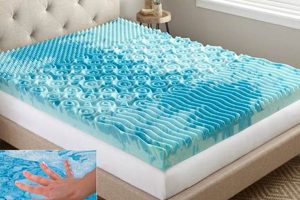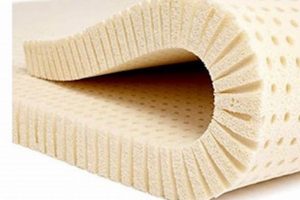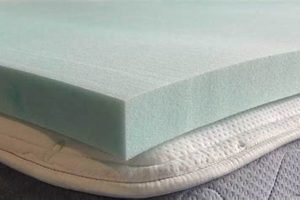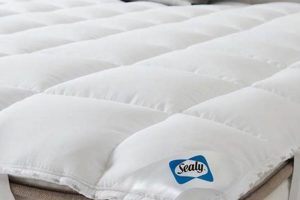A specialized storage solution designed for compressing and protecting bedding accessories. These bags typically utilize a vacuum-sealing process to remove air, reducing the overall volume of the item stored inside. For example, a thick memory foam layer can be flattened significantly using this method for easier transport or storage.
This method of storage is important because it minimizes the space required for bulky bedding, safeguarding it from dust, moisture, and pests. This can extend the life of the product and make it easier to move or store in compact areas. Historically, this technology has its roots in food preservation techniques, adapted and expanded for use with a wider range of compressible goods.
The subsequent discussion will cover the material composition of these bags, various sizes and functionalities available, and best practices for effective usage. Further examination includes addressing potential concerns and considerations.
Maximizing the Utility of Compression Storage for Bedding Accessories
The following guidelines ensure optimal utilization of air-tight sealed containers when storing bulky sleeping accessories.
Tip 1: Select the Appropriate Size: Evaluate the dimensions of the mattress topper before purchase. An undersized container will prevent complete sealing, while an oversized one wastes storage space.
Tip 2: Thoroughly Clean the Bedding: Prior to sealing, ensure the bedding is clean and dry. Residual moisture can lead to mold growth within the sealed environment.
Tip 3: Employ Correct Folding Techniques: Fold the bedding neatly and compactly before insertion into the container. This facilitates efficient compression and reduces the risk of creasing.
Tip 4: Utilize a Compatible Vacuum: Verify that the vacuum cleaner nozzle is compatible with the bag’s valve. An improper seal will negate the air removal process.
Tip 5: Avoid Over-Compression: While maximizing space is the goal, excessive compression can damage the mattress topper’s internal structure. Monitor the compression level to prevent permanent deformation.
Tip 6: Store in a Controlled Environment: Maintain a stable temperature and humidity level in the storage area. Extreme temperature fluctuations can compromise the integrity of the bag and its contents.
Tip 7: Inspect Periodically: Regularly examine the container for leaks or punctures. If damage is detected, reseal the contents immediately to maintain the protective environment.
Tip 8: Label Contents Clearly: Indicate the contents and the date of sealing on the exterior of the container. This simplifies identification and inventory management.
Adhering to these recommendations can prolong the lifespan of bedding accessories and enhance storage efficiency. The implementation of proper preparation and maintenance procedures maximizes the efficacy of compression storage.
The subsequent section will address common troubleshooting scenarios and offer solutions for resolving issues encountered during the sealing and storage processes.
1. Airtight Seal
The airtight seal is a fundamental component of the mattress topper vacuum bag, essential for its proper function. Its absence renders the bag largely ineffective. The primary purpose of the bag is to compress a mattress topper for efficient storage and to protect it from environmental factors. Without a hermetic closure, air would re-enter the bag, negating the compression effect and permitting the infiltration of dust, moisture, and potential pests. For example, a memory foam topper stored in a leaking bag may expand, rendering space-saving benefits moot. More critically, moisture penetration can lead to mold growth, irreparably damaging the mattress topper.
The airtight seal is typically achieved through a combination of a robust zipper mechanism and a specialized valve. The zipper ensures that the bag itself remains closed, while the valve facilitates air expulsion via a vacuum cleaner. The valve design is critical; it must allow air to be suctioned out while simultaneously preventing air from flowing back in once the vacuum is removed. In practical application, consider moving scenarios where the bag is exposed to varying temperatures and pressures; a compromised seal means the topper is vulnerable to damage. This could easily negate the space-saving benefits.
In conclusion, the effectiveness of a mattress topper vacuum bag hinges directly on the integrity of its airtight seal. The seals absence or failure results in a loss of both compression and protection, negating the bags intended purpose. It is the cornerstone component dictating the usability. Therefore, regular inspection of the seal for wear and tear is crucial for long-term storage success and to ensure the toppers preservation. Furthermore, the importance of airtight seal should be strongly communicated to user.
2. Material Durability
Material durability is a critical determinant of a mattress topper vacuum bag’s longevity and effectiveness. The bag’s ability to withstand repeated use, pressure from compression, and potential environmental stressors is directly linked to the quality of its construction materials.
- Puncture Resistance
The bag must resist punctures from sharp edges or corners of the mattress topper itself, as well as potential abrasions encountered during storage or transportation. A tear or puncture compromises the airtight seal, rendering the bag ineffective. Heavy-gauge polyethylene or nylon-reinforced materials are commonly employed to mitigate this risk. For example, a bag made of thin, low-density plastic is far more susceptible to damage than one constructed from a multi-layered, puncture-resistant composite.
- Tensile Strength
Tensile strength refers to the material’s ability to withstand pulling forces without tearing or stretching excessively. The vacuum compression process exerts significant force on the bag’s seams and surfaces. Insufficient tensile strength can lead to seam failure or material deformation, again compromising the airtight seal. Reinforced seams and high-density materials contribute to enhanced tensile strength. A bag with weak seams may split under pressure, releasing the vacuum and exposing the topper to the environment.
- Flexibility and Cold-Crack Resistance
The material must maintain its flexibility even at low temperatures to prevent cracking. Cold temperatures can make certain plastics brittle, increasing the risk of tears or punctures if the bag is handled while cold. Materials with additives to enhance flexibility and cold-crack resistance are preferred. For example, storing a bag in an unheated garage during winter could cause a brittle material to crack upon movement, destroying the integrity of the bag.
- UV Resistance
Extended exposure to ultraviolet (UV) radiation can degrade certain plastics, making them brittle and prone to cracking. If the bag is stored in a location with significant sunlight exposure, UV-resistant materials are essential for preserving its structural integrity. UV inhibitors can be added to the plastic during manufacturing to enhance its resistance to degradation. Direct exposure of a non-UV resistant bag to sunlight will eventually lead to the plastic becoming brittle.
The durability of the material directly impacts the mattress topper vacuum bag’s performance and lifespan. Selecting a bag constructed from high-quality, durable materials is essential for ensuring long-term protection and efficient storage of the mattress topper, mitigating the risks associated with punctures, tears, and environmental degradation.
3. Volume Reduction
Volume reduction is a primary function and key benefit of employing a mattress topper vacuum bag. The underlying principle involves removing air from the space surrounding the mattress topper, thereby compressing the topper’s dimensions. This compression directly translates to a smaller overall volume occupied by the stored item, enabling more efficient utilization of storage spaces. The effect is most pronounced with materials like memory foam, which contain a high percentage of air within their structure. For instance, a six-inch memory foam topper may be compressed to a thickness of two inches or less, resulting in a significant reduction in required storage space. This process addresses the challenge of storing bulky bedding accessories, particularly in environments with limited space availability.
The implementation of volume reduction through a mattress topper vacuum bag has practical applications in various scenarios. During relocation, compressed mattress toppers occupy less space in moving vehicles, potentially reducing transportation costs. In residential settings, seasonal storage of bedding accessories, such as winter mattress toppers during summer months, becomes more manageable. Moreover, reduced volume facilitates easier handling and maneuverability of the stored item, minimizing the risk of damage during movement. The effectiveness of the volume reduction depends on factors such as the initial thickness and composition of the mattress topper, as well as the quality and sealing capacity of the container. Lower quality bags may allow air to slowly re-enter, reducing volume reduction over time.
In summary, volume reduction is an intrinsic aspect of mattress topper vacuum bag functionality, providing tangible benefits in storage efficiency, transportation, and handling. The degree of reduction achieved is contingent upon the topper’s material properties and the bag’s performance characteristics. Understanding this relationship is crucial for selecting the appropriate bag and optimizing its use for specific storage needs. Potential challenges include the possibility of long-term compression affecting the topper’s original form. However, the benefits derived from substantial volume reduction often outweigh these concerns, making it an attractive storage solution.
4. Protective Barrier
The “Protective Barrier” aspect of a mattress topper vacuum bag directly contributes to the preservation and longevity of the stored bedding accessory. This function extends beyond mere volume reduction, encompassing the safeguarding of the mattress topper from a range of potentially damaging environmental factors.
- Moisture Intrusion Prevention
The bag acts as a barrier against humidity and water exposure. This is crucial because moisture can lead to the growth of mold and mildew within the mattress topper, causing irreversible damage and rendering it unusable. For instance, storing a memory foam topper in a damp basement without adequate protection will likely result in microbial growth, necessitating its disposal. A properly sealed vacuum bag mitigates this risk effectively.
- Dust Mite and Allergen Exclusion
The airtight seal prevents the ingress of dust mites, allergens, and other particulate matter. These contaminants can accumulate within the mattress topper over time, triggering allergic reactions and respiratory issues upon subsequent use. A vacuum-sealed bag isolates the topper from these irritants, maintaining its cleanliness and hygiene. This is particularly relevant for individuals with allergies or asthma.
- Pest Infestation Resistance
The bag provides a physical barrier against insects, rodents, and other pests that may seek refuge or nourishment within the mattress topper. These infestations can cause significant damage to the material, rendering it unsanitary and potentially unsafe. A sealed bag denies pests access to the topper, preventing infestation and preserving its structural integrity.
- Odor Absorption Mitigation
The bag helps to minimize the absorption of unpleasant odors from the surrounding environment. Porous materials like memory foam are susceptible to absorbing smells, which can be difficult to remove. Sealing the topper within a vacuum bag reduces its exposure to external odors, keeping it fresh and ready for use. This is particularly important in storage environments with strong or lingering smells.
Consequently, the protective barrier afforded by a mattress topper vacuum bag is essential for maintaining the quality and usability of the stored item. It safeguards against moisture, allergens, pests, and odors, thereby prolonging the lifespan and ensuring the hygienic condition of the mattress topper. The level of protection is directly proportional to the integrity of the bag’s seal and the quality of its construction materials.
5. Size Compatibility
Size compatibility is a foundational consideration in the effective utilization of bedding accessory compression containers. Proper matching of the container’s internal dimensions to the mattress topper’s external dimensions is paramount for successful compression, storage, and protection. Mismatched sizes can compromise the integrity of the sealing process and increase the risk of damage to the contained item.
- Internal Volume and Topper Dimensions
The container’s internal volume must sufficiently accommodate the uncompressed mattress topper while allowing for effective air extraction. A container that is too small will impede proper closure and may result in material stress or tearing. Conversely, an excessively large container may not provide adequate compression, diminishing the space-saving benefits. For example, attempting to store a queen-size mattress topper in a container designed for a twin-size will prevent complete sealing. A container with appropriate internal volume allows the topper to be fully enclosed without undue stress, facilitating optimal compression.
- Zipper Closure Length and Access
The length of the zipper closure must be adequate to allow for easy insertion and removal of the mattress topper. A short or obstructed zipper can complicate the packing process and increase the likelihood
of damage to both the topper and the container. Moreover, the zipper’s placement should facilitate convenient access for loading and unloading. A zipper extending along three sides of the container provides greater access compared to a zipper located only on one side. A limited zipper opening forces the user to fold topper improperly. The easier closure and topper insertion with proper zipper help prevent zipper malfunctions and tearing. - Valve Placement and Accessibility
The positioning of the vacuum valve should allow for easy connection to a standard vacuum cleaner nozzle, even when the container is fully packed. An inaccessible valve can impede the air extraction process, reducing the effectiveness of compression. The valve should also be located in a position that minimizes obstruction from the mattress topper itself. If the valve is obstructed by the topper, the vacuum cleaner might have difficulty creating a good seal. Clear and unobstructed valve is essential for effective and easy air removal.
- Weight Capacity and Material Stress
While not strictly a dimensional concern, the container’s material strength must be sufficient to support the weight of the mattress topper, especially when compressed. Overloading the container can lead to seam failure or material rupture, compromising the airtight seal. The manufacturer’s stated weight capacity should be carefully considered and not exceeded. A heavy memory foam topper might exert excessive pressure on the seams if the container is not designed to handle the weight, leading to damage. A container with insufficient material causes seal damages and also material damages.
Failure to adequately consider size compatibility can negate the intended benefits of using a mattress topper compression container. The result will be ineffective compression and increase damage risk. Attention to these dimensional and weight-related factors is crucial for optimizing storage efficiency, protecting the mattress topper, and ensuring the long-term usability of the container.
6. Valve Design
Valve design is an indispensable element of any mattress topper vacuum bag system, fundamentally dictating the efficiency and effectiveness of air extraction. The valve serves as the sole pathway for removing air from the bag’s interior, thereby enabling compression and subsequent space reduction. A poorly designed valve can impede airflow, prolong the compression process, or, critically, fail to maintain the vacuum seal once air extraction ceases. Consider a valve with inadequate backflow prevention; air will slowly re-enter the bag, negating the compression effort and exposing the mattress topper to environmental elements. The success of the compression and protective functionalities hinges on effective valve performance.
Different valve designs exist, each offering varying levels of performance and convenience. One-way valves with internal flaps or diaphragms are common, designed to allow unidirectional airflow outward while preventing air from re-entering. The material composition of the valve, typically rubber or silicone, influences its durability and sealing capabilities. Valve placement on the bag also impacts usability; a centrally located valve facilitates more even compression compared to a valve positioned at one corner. Some advanced systems incorporate two-stage valves: a large-diameter opening for rapid air removal and a secondary, smaller valve for fine-tuning the vacuum and ensuring a tighter seal. These examples highlight the spectrum of considerations in valve design. A properly designed valve allows for efficient air extraction and maintain the compressed state for long periods of time.
In conclusion, valve design represents a critical engineering consideration in the overall performance of mattress topper vacuum bags. A robust and efficient valve is essential for achieving optimal volume reduction and maintaining a protective barrier against external contaminants. Substandard valve designs can lead to compromised compression, seal failures, and reduced storage effectiveness. The selection of appropriate valve design involves balancing airflow efficiency, seal integrity, material durability, and user convenience, all of which are paramount to achieving the desired benefits of using such a vacuum bag. By choosing good quality design, storage efficiency can be maximized, maintaining the protective barrier and ensure the expected benefits of using the vacuum bag.
7. Reusable Nature
The reusable nature of a mattress topper vacuum bag significantly enhances its value proposition, transitioning it from a single-use disposal item to a durable, long-term storage solution. This inherent characteristic has implications for cost-effectiveness, environmental impact, and overall user convenience.
- Material Durability and Repeated Use
The viability of reuse is intrinsically linked to the material’s ability to withstand repeated compression and decompression cycles. High-quality, puncture-resistant polymers are necessary to prevent tears or breaches that would compromise the airtight seal. A bag intended for reuse must endure the stresses associated with multiple packing, vacuuming, and storage periods without degradation. For example, a bag constructed from thin, low-grade plastic may be suitable for a single use but will likely fail after only a few cycles, negating its reusability.
- Zipper and Valve Longevity
The zipper and valve components are critical points of potential failure in a reusable system. The zipper must maintain its integrity and sealing capability over numerous opening and closing actions. The valve must continue to provide a reliable airtight seal after repeated vacuuming cycles. Durable materials and robust construction are essential to ensure the longevity of these components. Inferior zippers may break or become misaligned, while poorly designed valves may lose their ability to maintain a vacuum, thereby limiting the bag’s reusability.
- Cost-Effectiveness Over Time
The initial investment in a reusable vacuum bag may be higher than that of a disposable alternative. However, the long-term cost-effectiveness of a reusable bag becomes apparent with repeated use. The cumulative cost of purchasing multiple single-use bags over time can easily exceed the cost of a single, durable, reusable option. This makes reusable bags a financially prudent choice for individuals who require frequent or long-term storage solutions for mattress toppers.
- Environmental Impact Reduction
Reusable vacuum bags contribute to environmental sustainability by reducing the volume of plastic waste generated by single-use alternatives. By extending the lifespan of a storage solution, the demand for new plastic production and disposal is reduced, minimizing the environmental footprint. This aligns with growing consumer awareness and preference for eco-friendly products that promote resource conservation and waste reduction.
In summation, the reusable nature of a mattress topper vacuum bag is a multifaceted benefit that encompasses material durability, component longevity, cost savings, and environmental responsibility. Its long-term value is contingent upon selecting a product constructed from high-quality materials and designed for repeated use. This consideration is essential for maximizing the return on investment and minim
izing the environmental impact associated with storage solutions.
Frequently Asked Questions
This section addresses common inquiries regarding the utilization, benefits, and limitations of specialized containers designed for compressing and storing bedding accessories.
Question 1: Can any vacuum cleaner be used to evacuate air from these storage solutions?
While most standard vacuum cleaners are compatible, compatibility hinges on nozzle design. A snug fit between the vacuum nozzle and the bag’s valve is imperative for establishing an airtight seal and facilitating effective air removal. Adapters may be required for certain vacuum models.
Question 2: Is there a risk of permanently damaging a memory foam mattress topper through compression storage?
Prolonged compression can potentially alter the structure of memory foam. However, the risk is minimized by avoiding excessive compression and periodically airing out the mattress topper during extended storage periods. Following manufacturer guidelines is crucial.
Question 3: How can the presence of moisture within the mattress topper be mitigated prior to sealing?
Thoroughly drying the mattress topper prior to storage is essential. Airing it out in direct sunlight, if feasible, or utilizing a dehumidifier in a closed environment can effectively remove residual moisture, preventing mold or mildew growth.
Question 4: What is the optimal storage environment for a sealed container?
A cool, dry environment with stable temperature and humidity is ideal. Exposure to extreme temperature fluctuations or direct sunlight should be avoided, as these conditions can compromise the integrity of the container and potentially damage the mattress topper.
Question 5: How often should the sealed container be inspected for leaks or breaches?
Regular inspection is recommended, particularly during extended storage periods. A visual examination for tears, punctures, or a loss of vacuum seal should be conducted at least every three months. Any detected damage necessitates immediate resealing or replacement of the container.
Question 6: Can mattress topper vacuum bags be used for international relocation?
Yes, these storage solutions are suitable for international relocation, providing protection and minimizing volume during transit. However, compliance with airline or shipping company regulations regarding packaging and dimensions remains the responsibility of the user.
The information provided herein serves as a general guide. Adherence to manufacturer instructions and diligent monitoring of storage conditions are essential for maximizing the benefits and minimizing potential risks associated with mattress topper compression containers.
The subsequent article section will delve into a comparative analysis of various available brands and models, highlighting their respective features and benefits.
Conclusion
This examination has illuminated the multifaceted nature of mattress topper vacuum bags, underscoring their role in efficient storage and safeguarding bedding accessories. Attributes such as airtight seals, material durability, and volume reduction are critical determinants of their performance and longevity. The preceding analysis clarifies that these storage solutions are not merely space-saving devices but also protective mechanisms against environmental degradation.
The informed consumer is thus equipped to make discerning choices regarding their purchase and utilization. Understanding the nuances of valve design, material composition, and size compatibility ensures optimal outcomes. While these bags offer significant advantages, prudent usage, including regular inspection and adherence to manufacturer guidelines, is essential for maximizing their benefits and minimizing the potential for damage. Future developments may yield even more sophisticated materials and designs, further enhancing the utility and extending the lifespan of these indispensable storage solutions.






